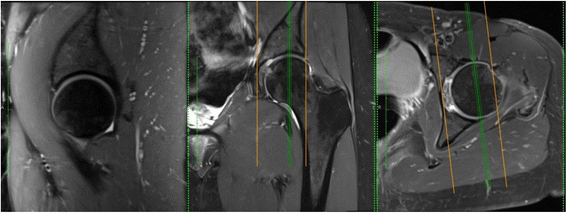Protocol for a multi-centre randomised controlled trial comparing arthroscopic hip surgery to physiotherapy-led care for femoroacetabular impingement (FAI): the Australian FASHIoN trial
- PMID: 28950859
- PMCID: PMC5615805
- DOI: 10.1186/s12891-017-1767-y
Protocol for a multi-centre randomised controlled trial comparing arthroscopic hip surgery to physiotherapy-led care for femoroacetabular impingement (FAI): the Australian FASHIoN trial
Abstract
Background: Femoroacetabular impingement syndrome (FAI), a hip disorder affecting active young adults, is believed to be a leading cause of hip osteoarthritis (OA). Current management approaches for FAI include arthroscopic hip surgery and physiotherapy-led non-surgical care; however, there is a paucity of clinical trial evidence comparing these approaches. In particular, it is unknown whether these management approaches modify the future risk of developing hip OA. The primary objective of this randomised controlled trial is to determine if participants with FAI who undergo hip arthroscopy have greater improvements in hip cartilage health, as demonstrated by changes in delayed gadolinium-enhanced magnetic resonance imaging (MRI) of cartilage (dGEMRIC) index between baseline and 12 months, compared to those who undergo physiotherapy-led non-surgical management.
Methods: This is a pragmatic, multi-centre, two-arm superiority randomised controlled trial comparing hip arthroscopy to physiotherapy-led management for FAI. A total of 140 participants with FAI will be recruited from the clinics of participating orthopaedic surgeons, and randomly allocated to receive either surgery or physiotherapy-led non-surgical care. The surgical intervention involves arthroscopic FAI surgery from one of eight orthopaedic surgeons specialising in this field, located in three different Australian cities. The physiotherapy-led non-surgical management is an individualised physiotherapy program, named Personalised Hip Therapy (PHT), developed by a panel to represent the best non-operative care for FAI. It entails at least six individual physiotherapy sessions over 12 weeks, and up to ten sessions over six months, provided by experienced musculoskeletal physiotherapists trained to deliver the PHT program. The primary outcome measure is the change in dGEMRIC score of a ROI containing both acetabular and femoral head cartilages at the chondrolabral transitional zone of the mid-sagittal plane between baseline and 12 months. Secondary outcomes include patient-reported outcomes and several structural and biomechanical measures relevant to the pathogenesis of FAI and development of hip OA. Interventions will be compared by intention-to-treat analysis.
Discussion: The findings will help determine whether hip arthroscopy or an individualised physiotherapy program is superior for the management of FAI, including for the prevention of hip OA.
Trial registration: Australia New Zealand Clinical Trials Registry reference: ACTRN12615001177549 . Trial registered 2/11/2015 (retrospectively registered).
Keywords: Arthroscopy; Fai; Femoroacetabular impingement syndrome; Hip; Orthopaedic; Osteoarthritis; Physiotherapy; Surgery; dGEMRIC.
Conflict of interest statement
Ethics approval and consent to participate
This protocol has been approved by St Vincent’s Hospital Human Research Ethics Committee (HREC/14/SVH/343). Informed consent was obtained from all study participants before participation in the study.
Competing interests
DJH is a consultant to Flexion, TissueGene and Merck Serono and is supported by an NHMRC Practitioner Fellowship. KLB is supported by a NHMRC Principal Research Fellowship. DRG is a consultant for Stryker UK. MH is a member of the Editorial Board of BMC Musculoskeletal Disorders.
Publisher’s Note
Springer Nature remains neutral with regard to jurisdictional claims in published maps and institutional affiliations.
Figures



Similar articles
-
Multi-centre randomised controlled trial comparing arthroscopic hip surgery to physiotherapist-led care for femoroacetabular impingement (FAI) syndrome on hip cartilage metabolism: the Australian FASHIoN trial.BMC Musculoskelet Disord. 2021 Aug 16;22(1):697. doi: 10.1186/s12891-021-04576-z. BMC Musculoskelet Disord. 2021. PMID: 34399702 Free PMC article. Clinical Trial.
-
Arthroscopic hip surgery compared with personalised hip therapy in people over 16 years old with femoroacetabular impingement syndrome: UK FASHIoN RCT.Health Technol Assess. 2022 Feb;26(16):1-236. doi: 10.3310/FXII0508. Health Technol Assess. 2022. PMID: 35229713 Free PMC article. Clinical Trial.
-
Efficacy of a physiotherapy rehabilitation program for individuals undergoing arthroscopic management of femoroacetabular impingement - the FAIR trial: a randomised controlled trial protocol.BMC Musculoskelet Disord. 2014 Feb 26;15:58. doi: 10.1186/1471-2474-15-58. BMC Musculoskelet Disord. 2014. PMID: 24571824 Free PMC article. Clinical Trial.
-
No evidence exists on outcomes of non-operative management in patients with femoroacetabular impingement and concomitant Tönnis Grade 2 or more hip osteoarthritis: a scoping review.Knee Surg Sports Traumatol Arthrosc. 2023 Jun;31(6):2103-2122. doi: 10.1007/s00167-022-07274-y. Epub 2022 Dec 9. Knee Surg Sports Traumatol Arthrosc. 2023. PMID: 36484811 Free PMC article.
-
Femoroacetabular impingement - What the rheumatologist needs to know.Best Pract Res Clin Rheumatol. 2024 Mar;38(1):101932. doi: 10.1016/j.berh.2024.101932. Epub 2024 Feb 9. Best Pract Res Clin Rheumatol. 2024. PMID: 38336510 Review.
Cited by
-
Arthroscopic surgery versus physiotherapy for femoroacetabular impingement: a meta-analysis study.Eur J Orthop Surg Traumatol. 2020 Oct;30(7):1151-1162. doi: 10.1007/s00590-020-02675-6. Epub 2020 May 7. Eur J Orthop Surg Traumatol. 2020. PMID: 32382825 Free PMC article. Review.
-
Do patients with femoroacetabular impingement syndrome who undergo hip arthroscopy display improved alpha angle (magnetic resonance imaging) and radiographic hip morphology?Int J Rheum Dis. 2023 Feb;26(2):354-359. doi: 10.1111/1756-185X.14530. Epub 2022 Dec 11. Int J Rheum Dis. 2023. PMID: 36502534 Free PMC article.
-
Effect of Psychosocial Interventions for Individuals Who Underwent Arthroscopy in Femoroacetabular Impingement: A Randomized Controlled Trial.J Clin Med. 2023 May 23;12(11):3612. doi: 10.3390/jcm12113612. J Clin Med. 2023. PMID: 37297807 Free PMC article.
-
Squatting biomechanics following physiotherapist-led care or hip arthroscopy for femoroacetabular impingement syndrome: a secondary analysis from a randomised controlled trial.PeerJ. 2024 Jun 24;12:e17567. doi: 10.7717/peerj.17567. eCollection 2024. PeerJ. 2024. PMID: 38938616 Free PMC article. Clinical Trial.
-
Teamwork in hip preservation: the ISHA 2019 Annual Scientific Meeting.J Hip Preserv Surg. 2020 Oct 9;7(Suppl 1):2-21. doi: 10.1093/jhps/hnaa037. eCollection 2020 Oct. J Hip Preserv Surg. 2020. PMID: 33072394 Free PMC article.
References
Publication types
MeSH terms
LinkOut - more resources
Full Text Sources
Other Literature Sources

